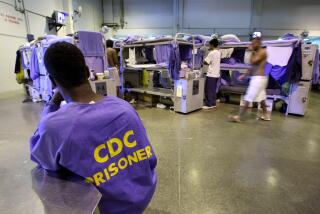Wilson Seeks to Boost AIDS Treatment Budget
- Share via
SACRAMENTO — Gov. Pete Wilson’s proposed budget, reflecting a rapid increase in the demand for new AIDS drug treatments, calls for a raise in state and federal government funding from $18 million two years ago to more than $86 million next year, senior administration officials said Saturday.
The money will go to the AIDS Drug Assistance Program--known as ADAP--which is jointly funded by federal and state governments. It is intended for patients who are uninsured and ineligible for Medi-Cal.
Wilson’s proposal--contained in a preview of the administration’s budget to be released this week--was promptly hailed by advocates for AIDS patients, who called it the first major signal that the state government has recognized a revolution in treatment programs developed in the last year.
Still, they said Wilson’s proposal is likely to be controversial because, for the first time, it calls on financially strapped local governments to help pay for drug treatments for indigent patients.
About one-third of the $86 million proposal would come from state funds. Local governments would be asked to pay about $13 million, with the remainder to be paid by federal sources.
“What’s significant about this major increase at the federal and state levels is that government is saying it will . . . meet the need,” said Michael Weinstein, president of the AIDS Healthcare Foundation in Los Angeles. “They will not allow people to die, at least in California.”
State officials said the governor’s proposal is especially significant compared to other states that have left some indigent patients without treatment.
“There is a lot going on in the HIV environment that compels us to develop a response within that context,” a senior administration official said.
Wilson’s budget proposal represents an increase over this year of about $11.7 million in state funds. If approved by the Legislature, that would raise California’s total contribution to about $28 million.
Democratic legislative officials said Saturday that it was too early to tell whether lawmakers will agree with the governor’s proposal.
Weinstein said the foundation had asked for at least $18 million in new funds from the state.
The governor, however, hopes to leverage the state contribution with about $12.9 million from nine local governments--including Los Angeles County. Those local governments--the hardest hit by the AIDS crisis--receive about $85 million for AIDS programs directly from the federal government.
But Weinstein said the new drug treatments are also stretching county budgets, which are financing the increased medical attention required to administer the prescriptions.
Optimism about the new drug treatments was highlighted last summer at the international AIDS conference in Vancouver. Researchers there disclosed that combinations of old and new drugs--called protease inhibitors--can prolong lives in AIDS patients by dramatically reducing virus levels in the blood.
The therapy is costly, however. It costs $12,000 to $16,000 a year per patient.
There are 16,194 patients now in the ADAP program in California. Slightly more than half of those have annual incomes under the federal poverty level of $7,471.
State officials said about 33,000 Californians have AIDS, with 8,000 more cases expected next year.
AIDS treatment strategies call for patients to receive treatment immediately after being diagnosed as HIV positive, before they progress to full-blown AIDS.
Weinstein estimated that the number of HIV cases is at least triple the number of AIDS cases.
Officials said Wilson’s budget will recommend also that some state money for AIDS programs be redirected.
The University of California has agreed to use $1 million of its $8 million state-funded AIDS research effort to explore the hypothesis that if the new drug treatments reduce HIV levels in the blood, they might in turn reduce the risk of HIV transmission from that person to another.
The governor also proposed that about $1.6 million for HIV testing at family planning centers be redirected to better target at-risk populations such as drug users and victims of other sexually transmitted diseases.
State officials said the money they spent at family planning centers last year identified only eight patients who tested positive for HIV.
More to Read
Get the L.A. Times Politics newsletter
Deeply reported insights into legislation, politics and policy from Sacramento, Washington and beyond. In your inbox twice per week.
You may occasionally receive promotional content from the Los Angeles Times.










